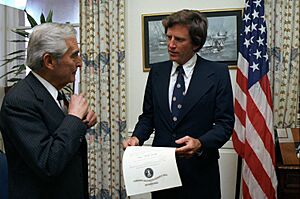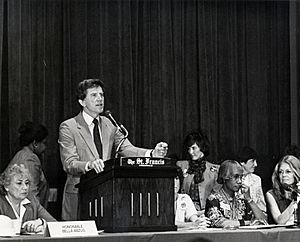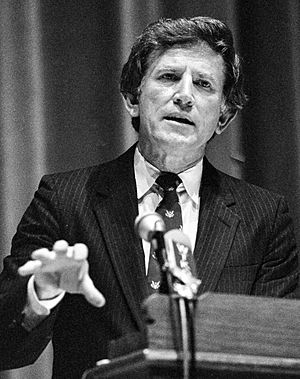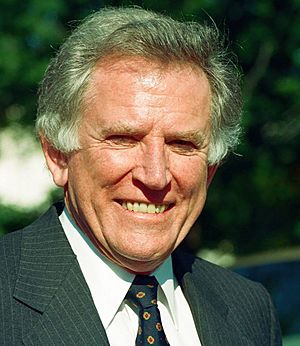Gary Hart facts for kids
Quick facts for kids
Gary Hart
|
|
|---|---|
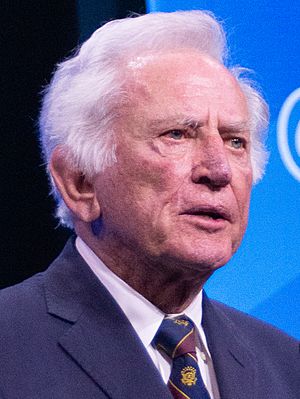
Hart in 2019
|
|
| United States Special Envoy for Northern Ireland | |
| In office October 21, 2014 – January 20, 2017 |
|
| President | Barack Obama |
| Preceded by | Declan Kelly (2011) |
| Succeeded by | Mick Mulvaney (2020) |
| Vice Chair of the Homeland Security Advisory Council | |
| In office June 5, 2009 – February 8, 2011 |
|
| President | Barack Obama |
| Preceded by | James Schlesinger |
| Succeeded by | Bill Bratton |
| United States Senator from Colorado |
|
| In office January 3, 1975 – January 3, 1987 |
|
| Preceded by | Peter Dominick |
| Succeeded by | Tim Wirth |
| Personal details | |
| Born |
Gary Warren Hartpence
November 28, 1936 Ottawa, Kansas, U.S. |
| Political party | Democratic |
| Spouse |
Oletha Lee Ludwig
(m. 1958; died 2021) |
| Children | 2 |
| Relatives | Martha Keys (sister-in-law) |
| Education |
|
| Military service | |
| Allegiance | |
| Branch | |
| Service years | 1980–unknown |
| Rank | |
| Unit |
|
Gary Warren Hart (born November 28, 1936) is an American politician, diplomat, and lawyer. He was a leading candidate for the Democratic Party's presidential nomination in 1984 and 1988. He represented the state of Colorado in the United States Senate from 1975 to 1987.
Born in Ottawa, Kansas, Hart became a lawyer in Denver, Colorado, after studying at Yale Law School. He helped manage Senator George McGovern's successful campaign for the Democratic presidential nomination in 1972. Hart then won a Senate seat in Colorado in 1974. As a Senator, he worked on important committees. He also led an investigation into the Three Mile Island accident, a nuclear power plant incident.
Hart ran for president in 1984 but lost the nomination to Walter Mondale. He decided not to run for re-election to the Senate in 1986. He tried again for president in 1988. He was a top candidate until intense media attention on his personal life caused him to leave the race. He briefly re-entered but later withdrew again.
After his political campaigns, Hart continued to work in public service. He co-chaired a task force on homeland security and served as a special envoy for Northern Ireland. He also earned a doctorate degree from the University of Oxford and has written several books.
Early Life and Education
Gary Hart was born in Ottawa, Kansas. His parents were Nina and Carl Riley Hartpence. His father sold farm equipment. When Gary was young, he worked on the railroad. In 1961, he and his father changed their last name to "Hart" because it was easier to remember.
Hart attended Bethany Nazarene College (now Southern Nazarene University) on a scholarship. He graduated in 1958 with a degree in philosophy. There, he met Oletha "Lee" Ludwig, and they married in 1958. He then studied at Yale Divinity School and Yale Law School, earning degrees in 1961 and 1964.
Political Career
Early Legal Work
From 1964 to 1965, Hart worked as a lawyer for the United States Department of Justice. He was allowed to practice law in Colorado and Washington, D.C., in 1965. He then worked for the United States Department of the Interior before joining a private law firm in Denver, Colorado.
George McGovern's 1972 Presidential Campaign
After the 1968 Democratic Convention, Senator George McGovern helped change how the Democratic Party chose its presidential candidates. The new rules made it easier for new people to get involved.
In the 1972 primary elections, McGovern chose Hart to lead his national campaign. Hart and his team focused on states that used caucuses, which are local meetings where people choose their preferred candidate. This strategy helped McGovern win the nomination. However, McGovern lost the main election to President Richard Nixon.
Serving as a United States Senator
In 1974, Gary Hart ran for the United States Senate in Colorado. He challenged the Republican Senator Peter Dominick. Hart won by a large amount and was seen as a rising star in politics.
As a Senator, he joined the Armed Services Committee. He supported changes to how the military bought equipment. He also wanted the military to use smaller, more mobile weapons. Hart was part of the Church Committee, which investigated government agencies like the Central Intelligence Agency (CIA) and the Federal Bureau of Investigation (FBI)]. He also led the Senate investigation into the Three Mile Island accident, a nuclear power plant incident in Pennsylvania.
In 1980, Hart ran for a second term. He won a close election against Mary Estill Buchanan. Hart was one of only four senators to vote against a plan for MX missiles in 1981. He also helped create the Semiconductor Chip Protection Act of 1984. This law protected the designs of computer chips from being copied. Because of this, Hart became known as a leader of the "Atari Democrats," a group of Democrats interested in technology and new ideas.
In the late 1970s, Hart applied to join the United States Navy Reserve. He was older than the usual age limit and had no previous military experience. He said he wanted to understand and communicate better with military members.
After his re-election in 1980, Hart was commissioned as a lieutenant (junior grade) in the Navy's legal branch. He was promoted to lieutenant in 1982. Although he did not often perform reserve duties, he said his service helped him appreciate the military.
1984 Presidential Campaign

In 1983, Hart announced he would run for president in the 1984 election. At first, he was not well-known compared to other candidates like former Vice President Walter Mondale. To gain attention, Hart campaigned early in New Hampshire. This strategy worked, and he won the New Hampshire primary, surprising many. He quickly became Mondale's main challenger.
Hart's campaign focused on "new ideas." However, he faced challenges. Mondale had more money and better organization, especially with labor unions. Hart's campaign also had financial debt. Some people questioned Hart's background because he had changed his last name and sometimes used a different birth year. He also had two separations from his wife, Lee, which led to media questions about his personal life. The Harts later said these separations, caused by time apart due to politics, made their marriage stronger.
The two candidates traded wins in the primary elections. Mondale often made fun of Hart's "new ideas," famously asking, "Where's the beef?" This phrase came from a popular TV commercial. Hart's campaign struggled to respond effectively.
Mondale eventually gained enough delegates to win the nomination. Hart tried to become Mondale's running mate (Vice President), but Mondale chose Geraldine Ferraro instead. Mondale later lost the general election to President Ronald Reagan. Many people felt that Hart represented the future of the Democratic Party with his new ideas.
1988 Presidential Campaign
Hart decided not to run for re-election to the Senate in 1986, planning to run for president again. By early 1987, he was seen as the leading candidate for the Democratic nomination.
Hart officially announced his candidacy on April 13, 1987. Soon after, intense media attention focused on his personal life. Reports and rumors about his private activities began to circulate. Hart stated that he was not involved in any inappropriate relationships and felt he was being unfairly targeted. He also said that his "follow me around" comment, made in frustration, was meant to invite observation of his public behavior, not private.
The media coverage of his personal life became very intense. It overshadowed his campaign message. Hart's staff believed that voters were not as concerned about these issues as the media was. However, the constant focus made it hard for him to get his message across and raise money.
On May 8, 1987, Hart suspended his campaign. He explained that he refused to subject his family and friends to further rumors and gossip. He felt the media's need to "dissect" him made it impossible to continue. Hart warned that this kind of media scrutiny could harm the country's ability to choose good leaders.
In December 1987, Hart re-entered the race, saying, "Let's let the people decide!" He wanted to share his ideas on economics and foreign policy. However, he faced more negative stories about old debts from his 1984 campaign. He did not perform well in the early primary elections and withdrew from the campaign a second time. Michael Dukakis won the Democratic nomination but lost the general election in 1988.
Later Career and Public Service
After his presidential campaigns, Hart returned to his law practice. He remained involved in public policy. He co-chaired the US Commission on National Security/21st Century, also known as the Hart-Rudman Commission. This group studied U.S. homeland security and warned of future terrorist attacks. Hart even met with National Security Adviser Condoleezza Rice in September 2001, just before the September 11 attacks, to urge faster action on homeland security.
Hart earned a doctorate degree in politics from the University of Oxford in 2001. He has also written many books and articles. Since 2005, he has been a writer for HuffPost. He is a member of the Council on Foreign Relations, an organization that studies international issues.
Hart has taught at the University of Colorado at Denver, Oxford University, and Yale University. He is involved with several groups focused on national security and foreign policy, including the American Security Project. He also served as the Vice-Chair of the Advisory Council for the U.S. Secretary of Homeland Security.
U.S. Special Envoy for Northern Ireland
In October 2014, President Barack Obama and Secretary of State John Kerry appointed Hart as the new United States Special Envoy for Northern Ireland. In this role, he worked to help with peace and stability in Northern Ireland. He was the second former U.S. Senator to hold this important position.
Electoral History
Colorado United States Senate election, 1974 (Democratic primary):
- Gary Hart – 81,161 (39.92%)
- Herrick S. Roth – 66,819 (32.86%)
- Martin P. Miller – 55,339 (27.22%)
Colorado United States Senate election, 1974
- Gary Hart (D) – 471,688 (57.23%)
- Peter H. Dominick (R) (inc.) – 325,526 (39.50%)
- John McCandish King (I) – 16,131 (1.96%)
- Joseph Fred Hyskell (Prohibition) – 8,404 (1.02%)
- Henry John Olshaw (Independent American) – 2,394 (0.29%)
Colorado United States Senate election, 1980:
- Gary Hart (D) (inc.) – 590,501 (50.34%)
- Mary Estill Buchanan (R) – 571,295 (48.70%)
- Earl Higgerson (Prohibition) – 7,265 (0.62%)
- Henry John Olshaw (I) – 4,081 (0.35%)
1984 Democratic presidential primaries:
- Walter Mondale – 6,952,912 (38.32%)
- Gary Hart – 6,504,842 (35.85%)
- Jesse Jackson – 3,282,431 (18.09%)
- John Glenn – 617,909 (3.41%)
- George McGovern – 334,801 (1.85%)
- Unpledged delegates – 146,212 (0.81%)
- Lyndon LaRouche – 123,649 (0.68%)
- Reubin O'Donovan Askew – 52,759 (0.29%)
- Alan Cranston – 51,437 (0.28%)
- Ernest Hollings – 33,684 (0.19%)
1984 Democratic National Convention:
- Walter Mondale – 2,191 (56.41%)
- Gary Hart – 1,201 (30.92%)
- Jesse Jackson – 466 (12.00%)
- Thomas Eagleton – 18 (0.46%)
- George McGovern – 4 (0.10%)
- John Glenn – 2 (0.05%)
- Joe Biden – 1 (0.03%)
- Martha Kirkland – 1 (0.03%)
1988 Democratic presidential primaries:
- Michael Dukakis – 9,898,750 (42.47%)
- Jesse Jackson – 6,788,991 (29.13%)
- Al Gore – 3,185,806 (13.67%)
- Dick Gephardt – 1,399,041 (6.00%)
- Paul M. Simon – 1,082,960 (4.65%)
- Gary Hart – 415,716 (1.78%)
- Unpledged delegates – 250,307 (1.07%)
- Bruce Babbitt – 77,780 (0.33%)
- Lyndon LaRouche – 70,938 (0.30%)
- David Duke – 45,289 (0.19%)
- James Traficant – 30,879 (0.13%)
- Douglas Applegate – 25,068 (0.11%)
1988 Democratic National Convention:
- Michael Dukakis – 2,877 (70.09%)
- Jesse Jackson – 1,219 (29.70%)
- Richard Stallings – 3 (0.07%)
- Joe Biden – 2 (0.05%)
- Dick Gephardt – 2 (0.05%)
- Lloyd Bentsen – 1 (0.02%)
- Gary Hart – 1 (0.02%)
See also
 In Spanish: Gary Hart para niños
In Spanish: Gary Hart para niños
- Atari Democrat
- Buie Seawell


